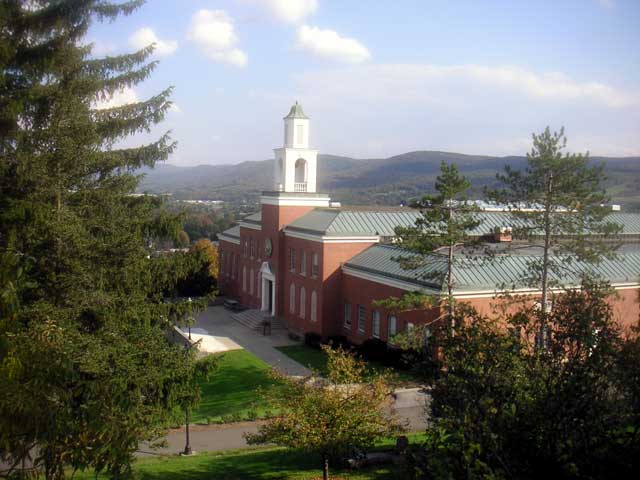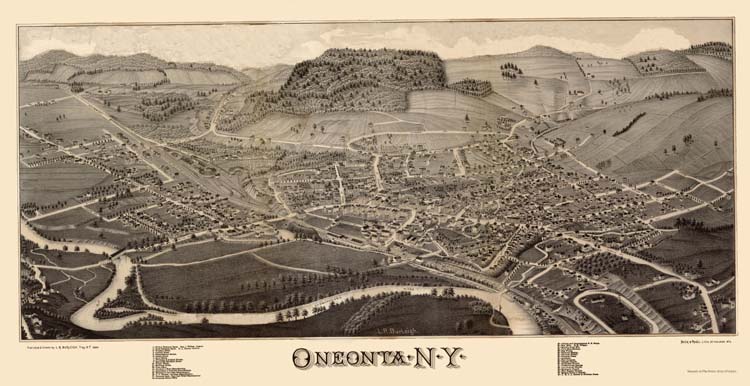|
Yager Museum
The Yager Museum of Art & Culture is located on the campus of Hartwick College in Oneonta, New York and is open to the public during the academic year; summer hours vary. The museum features archaeology collections from the Upper Susquehanna area of prehistoric and early Native American items. Other collections include ethnographic North and South American Indian artifacts, including baskets, pottery, clothing, rugs, jewelry, and masks, craft items from Micronesia, and fine art from the United States, Europe, Russia, and Asia. Among recent acquisitions are over 150 photographs and prints by Andy Warhol, given by the Andy Warhol Foundation for the Visual Arts as part of theiPhotographic Legacy Program Also on Hartwick's campus is thForeman Gallery a contemporary art gallery with several changing exhibitions per year. Together, the Yager Museum and the Foreman Gallery provide a focus for the college'Museum Studiesminor program. Students develop exhibitions and public programs ... [...More Info...] [...Related Items...] OR: [Wikipedia] [Google] [Baidu] |
Hartwick College
Hartwick College is a private liberal arts college in Oneonta, New York. The institution's origin is rooted in the founding of Hartwick Seminary in 1797 through the will of John Christopher Hartwick. In 1927, the seminary became a four-year college and moved to its current location. The college has 1,103 undergraduate students from 30 states and 22 countries, 187 faculty members, and a student-faculty ratio of 11:1. History Hartwick College traces its history to the will of Lutheran minister John Christopher Hartwick, who died in 1796. The following year, in 1797, the executors of his will decided to establish a seminary in his name. Establishing the Seminary, History, Hartwick College The first student graduated in 1803, and in 1816 the New York State Legislature incorporated the school—the first Lutheran |
Oneonta, New York
Oneonta ( ) is a Administrative divisions of New York#City, city in southern Otsego County, New York, Otsego County, New York (state), New York, United States. It is one of the northernmost cities of Appalachia. Oneonta is home to the State University of New York at Oneonta and Hartwick College. SUNY Oneonta began as a normal school and a teacher's college in 1889, and Hartwick College moved into the city in 1928. The approximately 5,800 students from SUNY Oneonta and the approximately 1,500 students at Hartwick make up a significant percentage of the population of Oneonta. According to the 2020 U.S. Census, Oneonta had a population of 13,079. Its nickname is "City of the Hills." While the word "oneonta" is of undetermined origin, it is popularly believed to mean "place of open rocks" in the Mohawk language. This refers to a prominent geological formation known as "Table Rock" at the western end of the city. The city is surrounded by the Administrative divisions of New York#Tow ... [...More Info...] [...Related Items...] OR: [Wikipedia] [Google] [Baidu] |
Archaeology
Archaeology or archeology is the study of human activity through the recovery and analysis of material culture. The archaeological record consists of Artifact (archaeology), artifacts, architecture, biofact (archaeology), biofacts or ecofacts, archaeological site, sites, and cultural landscapes. Archaeology can be considered both a social science and a branch of the humanities. It is usually considered an independent academic discipline, but may also be classified as part of anthropology (in North America – the four-field approach), history or geography. The discipline involves Survey (archaeology), surveying, Archaeological excavation, excavation, and eventually Post excavation, analysis of data collected, to learn more about the past. In broad scope, archaeology relies on cross-disciplinary research. Archaeologists study human prehistory and history, from the development of the first stone tools at Lomekwi in East Africa 3.3 million years ago up until recent decades. A ... [...More Info...] [...Related Items...] OR: [Wikipedia] [Google] [Baidu] |
List Of Counties In The Susquehanna River Watershed
The Susquehanna River is in the U.S. States of Maryland, Pennsylvania and New York. As of 2000, the Susquehanna drainage basin population was 3,968,635. Its total area is , and in 2000 were developed, were used for agriculture, were forested, were open water, were wetland, and were barren. By area, the Susquehanna basin accounts for 45% of Pennsylvania, 11% of New York, and 3% of Maryland . The drainage basin is divided into six subbasins by the Susquehanna River Basin Commission. These are: *Lower Susquehanna (green on the map at right) *Juniata River (pink) *West Branch Susquehanna River (orange) *Middle Susquehanna (purple) *Chemung River (Yellow) *Upper Susqehanna River (brown) Lower Susquehanna River Maryland Counties *Baltimore County * Carroll County *Cecil County *Harford County Pennsylvania Counties * Adams County *Berks County *Centre County *Chester County * Columbia County *Cumberland County *Dauphin County * Franklin County * Juniata County * Lancaster Cou ... [...More Info...] [...Related Items...] OR: [Wikipedia] [Google] [Baidu] |
Indigenous Peoples Of The Americas
In the Americas, Indigenous peoples comprise the two continents' pre-Columbian inhabitants, as well as the ethnic groups that identify with them in the 15th century, as well as the ethnic groups that identify with the pre-Columbian population of the Americas as such. These populations exhibit significant diversity; some Indigenous peoples were historically hunter-gatherers, while others practiced agriculture and aquaculture. Various Indigenous societies developed complex social structures, including pre-contact monumental architecture, organized city, cities, city-states, chiefdoms, state (polity), states, monarchy, kingdoms, republics, confederation, confederacies, and empires. These societies possessed varying levels of knowledge in fields such as Pre-Columbian engineering in the Americas, engineering, Pre-Columbian architecture, architecture, mathematics, astronomy, History of writing, writing, physics, medicine, Pre-Columbian agriculture, agriculture, irrigation, geology, minin ... [...More Info...] [...Related Items...] OR: [Wikipedia] [Google] [Baidu] |
Ethnographic
Ethnography is a branch of anthropology and the systematic study of individual cultures. It explores cultural phenomena from the point of view of the subject of the study. Ethnography is also a type of social research that involves examining the behavior of the participants in a given social situation and understanding the group members' own interpretation of such behavior. As a form of inquiry, ethnography relies heavily on participant observation, where the researcher participates in the setting or with the people being studied, at least in some marginal role, and seeking to document, in detail, patterns of social interaction and the perspectives of participants, and to understand these in their local contexts. It had its origin in social and cultural anthropology in the early twentieth century, but has, since then, spread to other social science disciplines, notably sociology. Ethnographers mainly use qualitative methods, though they may also include quantitative data. T ... [...More Info...] [...Related Items...] OR: [Wikipedia] [Google] [Baidu] |
Micronesia
Micronesia (, ) is a subregion of Oceania, consisting of approximately 2,000 small islands in the Northwestern Pacific Ocean. It has a close shared cultural history with three other island regions: Maritime Southeast Asia to the west, Polynesia to the east, and Melanesia to the south—as well as with the wider community of Austronesian peoples. The region has a tropical marine climate and is part of the Oceanian realm. It includes four main archipelagos—the Caroline Islands, the Gilbert Islands, the Mariana Islands, and the Marshall Islands — as well as numerous islands that are not part of any archipelago. Political control of areas within Micronesia varies depending on the island, and is distributed among six sovereign nations. Some of the Caroline Islands are part of the Republic of Palau and some are part of the Federated States of Micronesia (often shortened to "FSM" or "Micronesia"—not to be confused with the identical name for the overall region). The Gi ... [...More Info...] [...Related Items...] OR: [Wikipedia] [Google] [Baidu] |
Contemporary Art
Contemporary art is a term used to describe the art of today, generally referring to art produced from the 1970s onwards. Contemporary artists work in a globally influenced, culturally diverse, and technologically advancing world. Their art is a dynamic combination of Medium (arts), materials, methods, concepts, and subjects that continue the challenging of boundaries that was already well underway in the 20th century. Diverse and eclectic, contemporary art as a whole is distinguished by the very lack of a uniform, organising principle, ideology, or "-ism". Contemporary art is part of a cultural dialogue that concerns larger contextual frameworks such as personal and cultural identity, family, community, and nationality. In English, ''modern'' and ''contemporary'' are synonyms, resulting in some conflation and confusion of the terms ''modern art'' and ''contemporary art'' by non-specialists. Some specialists also consider that the frontier between the two is blurry; for instance, ... [...More Info...] [...Related Items...] OR: [Wikipedia] [Google] [Baidu] |
American Alliance Of Museums
The American Alliance of Museums (AAM), formerly the American Association of Museums, is a non-profit association whose goal is to bring museums together. Founded in 1906, the organization advocates for museums and provides "museum professionals with the resources, knowledge, inspiration, and connections they need to move the field forward." AAM represents the scope of museums, professionals, and nonpaid staff who work for and with museums. AAM represents more than 25,000 individual museum professionals and volunteers, 4,000 institutions, and 150 corporate members. Individual members include directors, curators, registrars, educators, exhibit designers, public relations officers, development officers, security managers, trustees, and Volunteering, volunteers. Museums represented by the members include art museum, art, history, science museum, science, military, maritime, and children's museum, youth museums, as well as public aquariums, zoos, botanical gardens, arboretums, histori ... [...More Info...] [...Related Items...] OR: [Wikipedia] [Google] [Baidu] |
University Art Museums And Galleries Of New York State
A university () is an institution An institution is a humanly devised structure of rules and norms that shape and constrain social behavior. All definitions of institutions generally entail that there is a level of persistence and continuity. Laws, rules, social conventions and ... of tertiary education and research which awards academic degrees in several Discipline (academia), academic disciplines. ''University'' is derived from the Latin phrase , which roughly means "community of teachers and scholars". Universities typically offer both undergraduate education, undergraduate and postgraduate education, postgraduate programs. The first universities in Europe were established by Catholic Church, Catholic monks. The University of Bologna (), Italy, which was founded in 1088, is the first university in the sense of: *being a high degree-awarding institute. *using the word (which was coined at its foundation). *having independence from the ecclesiastic schools and issuing se ... [...More Info...] [...Related Items...] OR: [Wikipedia] [Google] [Baidu] |






